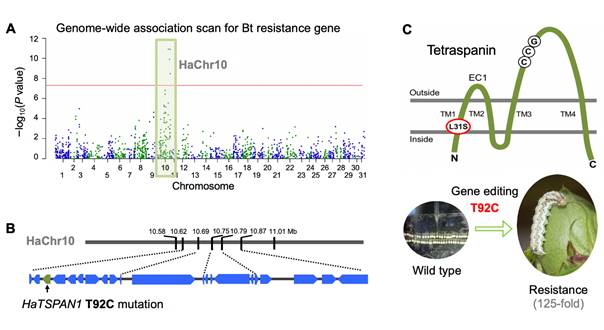Professor Wu Yidong from the College of Plant Protection, Nanjing Agricultural University found that a four-transmembrane protein-encoding gene (HaTSPAN1) caused a dominant resistance of the cotton bollworm to the Bt insecticidal protein Cry1Ac through point mutation (L31S). The important research results were published online on November 1st, 2018 in the Proceedings of the National Academy of Sciences (PNAS). Associate Professor Jin Lin and Ph.D. student Wang Jing are co-first authors, and Professor Wu Yidong is the author of the communication.
Helicoverpa armigera is a global pest, which is harmful to cotton, corn, soybean and other crops. Bt cotton expressing Cry1Ac protein can effectively control the cotton bollworm population. However, under the long-term selection pressure of Bt cotton, cotton bollworm can evolve many types of resistance genes, which significantly reduce or even completely lose insect resistance. Professor Wu Yidong's team carried out systematic research and exploration on the occurrence and development of resistance to Bt cotton in cotton bollworm in China, and achieved many landmark achievements. Genetic screening revealed the genetic diversity of Bt resistance in the population of cotton bollworm in China (PNAS, 2012); through systematic monitoring and computer simulation, it was clarified that the natural shelter protection strategy can effectively delay recessive resistance, but dominant Resistance will accelerate evolution (Nature Biotechnology, 2015); the result of this study is the discovery of a novel genetic mutation that causes the dominant resistance of cotton bollworm Bt. Professor Wu Yidong said, "This is the trilogy of Bt resistance research of cotton bollworm that our team has completed over ten years."

Point mutation of the HaTSPAN1 gene of Helicoverpa armigera leads to dominant resistance to Bt
Using genome-wide association analysis and gene fine mapping, the Bt dominant resistance gene of Helicoverpa armigera was mapped to a specific region of 250 kb on chromosome 10 of Helicoverpa armigera, and the base sequence and expression level of 21 functional genes in this region were performed. In comparison, a T92C point mutation occurred in HaTSPAN1, a four-transmembrane protein-encoding gene, which resulted in the mutation of the 31th leucine to serine, which was closely linked to Bt dominant resistance. Knockdown of the resistant line HaTSPAN1 gene by CRISPR/Cas9 gene editing technology resulted in complete disappearance of Cry1Ac resistance, and knocking of T92C point mutation into sensitive lines yielded 125-fold resistance. The above positive and reverse genetic evidences clarify the causal relationship between the T92C point mutation of the HaTSPAN1 gene and the Bt dominant resistance of the cotton bollworm.
It is generally believed that pests can develop resistance through loss-of-function mutations in Bt toxin receptor genes (such as cadherin and ABC transporters), which are recessive, and alleles must be homozygous to exhibit resistance. Sex. However, the resistance obtained by the function-acquired mutations found in this study is dominant inheritance, and the resistance alleles are resistant under heterozygosity, so the dominant resistance develops faster than the recessive resistance. This study found that the frequency of T92C mutation in the HaTSPAN1 gene of cotton bollworm in the North China cotton region is increasing rapidly, and has increased 100-fold in the past ten years, from 0.1% in 2006 to 10% in 2016.
At present, 14 countries are planting Bt cotton to control and control cotton bollworm and other pests, facing the common threat of Bt resistance of target pests. It is clear that Bt resistance genes and their temporal and spatial dynamics are prerequisites for treatment resistance. The research results of this paper are expected to provide technical support for the monitoring and early warning of Bt dominant resistance of cotton bollworm in China and other countries, and provide an important basis for formulating targeted resistance management strategies.
Paper link:
http://www.pnas.org/content/early/2018/10/30/1812138115